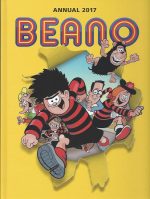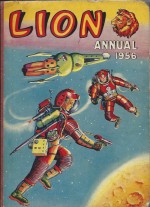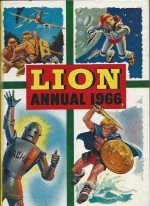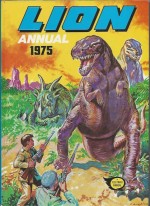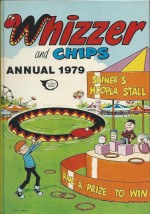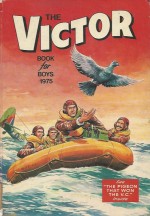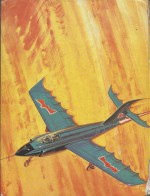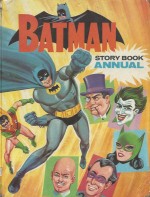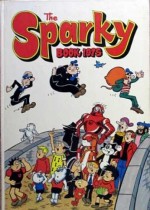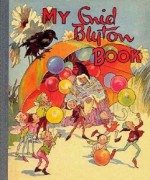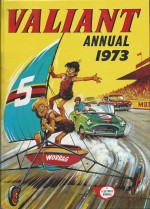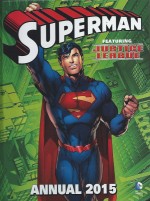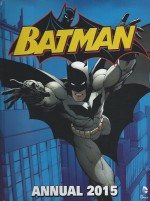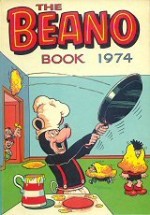In keeping with my self-imposed Holiday tradition here’s another pick of British Annuals selected not just for nostalgia’s sake but because it’s my house and my rules…
After decades when only American comics and memorabilia were considered collectable or worthy, the resurgence of interest in home-grown material means there’s lots more of this stuff available and if you’re lucky enough to stumble across a vintage volume or modern facsimile, I hope my words convince you to expand your comfort zone and try something old yet new…
Still topping my Xmas wish-list is further collections from fans and publishers who have begun to rescue this magical material from print limbo in (affordable) new collections…
Great writing and art is rotting in boxes and attics or the archives of publishing houses, when it needs to be back in the hands of readers once again. As the tastes of the reading public have never been broader and since a selective sampling of our popular heritage will always appeal to some part of the mass consumer base, let’s all continue rewarding publishers for their efforts and prove that there’s money to be made from these glorious examples of our communal childhood.
Lion Annual 1967
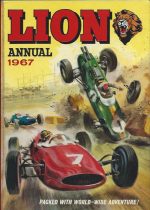
By many and various (Fleetway)
No ISBN: ASIN: B001Q8Y308
From the late 1950s and increasingly through the 1960s, Scotland’s DC Thomson steadily overtook their London-based competitors – monolithic comics publishing giant Amalgamated Press.
Created by Alfred Harmsworth at the beginning of the twentieth century, AP perpetually sought to regain lost ground, and the sheer variety of material the southerners unleashed as commercial countermeasures offered incredible vistas in adventure and – thanks to the defection of Leo Baxendale and Ken Reid to the enemy – eventually found a wealth of anarchic comedy material to challenge the likes of the Bash Street Kids, Dennis the Menace, Minnie the Minx and their unruly ilk.
During the latter end of that period the Batman TV show sent the entire world superhero-crazy. Amalgamated had almost finished absorbing all its other rivals such as Eagle‘s Hulton Press to form Fleetway/Odhams/IPC and were about to incorporate American superheroes into their heady brew of weekly thrills.
Once the biggest player in children’s comics, Amalgamated had stayed at the forefront of sales by latching onto every fad: keeping their material contemporary, if not fresh. The all-consuming company began reprinting the early successes of Marvel comics for a few years; feeding on the growing fashion for US style adventure which had largely supplanted the rather tired True Blue Brit style of Dan Dare or DC Thompson’s Wolf of Kabul.
Even though sales of all British comics were drastically declining, the 1960s were a period of intense and impressive innovation with publishers embracing new sensibilities and constantly trying new types of character and tales. At this time Lion and its stable-mate Valiant were the Boys’ Adventure big guns (although nothing could touch DC Thomson’s Beano and Dandy in the comedy arena).
From that creative zenith comes this sturdy compendium: the 14th Lion Annual (on sale from the end of August 1966) which opens in a blaze of colour with history-feature ‘Famous Planes of World War II’, delivering the crucial specs on the ten most famous flying craft of the conflict as well as the captivating Contents of what’s to come.
The comic action commences with a fully-coloured painted exploit of a beloved icon. ‘Robot Archie and the Invaders’ (illustrated by Alan Philpott) pits the metal marvel and his human sidekicks Ted Ritchie and Ken Dale against malign interplanetary mechanoids.
Created by E. George Cowan & Philpott The Jungle Robot had debuted in Lion‘s first issue in 1952 but vanished from sight after his initial serial. On his return in 1957 Archie became one of the most popular heroes of the British scene.
Prose thriller ‘“Avenger†versus the Atom Sub’ has potent spot illustrations from Bill Lacey and tells how Canadian reporters Rick Slade and Bill Hanley are crucial in scuppering the schemes of mad scientist Dr. Felipe Estramadura and returning a nuclear super submersible to its rightful owners. Then ultra-observant ‘Zip Nolan – Highway Patrol’ motorcycle cop shines in a short strip by Leo Rawlings, explosively capping a blazing oil well…
Joe Colquhoun’s venerable sky warrior ‘Paddy Payne – Fighter Ace!’ solves the mystery of seemingly invisible German fighter planes as a teaser to a glossy monochrome essay feature on pilots who won the Victoria Cross in ‘Warriors with Wings’ (accompanying art from John Batchelor), Graham Coton’s ‘Secrets of the Sea’ shares ghostly tales of nautical mystery and ‘The Bird That Flies Through Space’ reveals the photo-packed details of the then-latest advances in satellite technology.
The fascination of military gaming is explored in ‘War on Your Table Top’ before the comics strike back with medieval crusader ‘Maroc the Mighty’ losing his strength-enhancing magic bracelet yet still overcoming a vile feudal tyrant in a supernatural thriller by Alfredo Marculeta…
Pilot and troubleshooter Steve Darby invades an ‘Island of Secrets’ in text tale of modern-day piracy limned by John Vernon before Tarzan spoof ‘Charlie of the Chimps’ (by Colquhoun or possibly Spanish artist Rafart?) gets into all sorts of bother looking for breakfast.
In ‘The Return of the Sludge’ Lacey paints an all-colour classic as Slade and Hanley face again the all-consuming muck-monster which almost devoured the Earth. With their previous solution now untenable the ingenious journalists are forced to consider a nuclear option…
Coton then embellishes a tense prose tale of Court Martial in ‘Bill Duggan – Sapper Sergeant in King’s Corporal’ before a general knowledge ‘Picture Quiz’ takes us to a Ted Kearnon episode of ‘Zip Nolan – Highway Patrol’ who saves a visiting dignitary from assassination.
The story of the fall of Tippoo Sultan is revealed in text essay ‘The Tiger of Mysore’ after which ‘Robot-Archie and the Z-Ray’ (John Vernon) finds the irrepressible artificial avenger battling a mad scientist in all his monochrome glory before Coton offers more spooky sightings in eerie essay ‘Seen Any Good Ghosts Lately?’
More glossily formal fact-checking follows in photo features on ‘Living Under the Sea’, ‘Trains’, ‘Machines That See in the Dark’ and ‘Armoured Giants’ (tanks to you and me) until the indisputable star of the book makes his unmistakable presence felt.
The Spider was a mysterious super-scientist whose goal was to be the greatest criminal in the world. As conceived by Ted Cowan, he began his public career by forming a small team of crime specialists and when he decided fighting villains was more of a challenge he ordered Professor Pelham and cracksman Roy Ordini to reform too… with limited success.
Painted here in turbulent duo-tones of magenta and black by sublime stylist Reg Bunn, ‘The Spider in Cobra Island’ finds our reformed super-thief challenging a monstrous fiend turning people into zombie slaves and delivers his unique form of justice once again…
Vernon illustrates the prose yarn of ‘The Micro King’ with Special Investigator Mark Zeppelin hard-pressed to catch a maniac with a shrinking ray
In glittering red-&-black the history of elite military regiment The Green Howards is detailed in strip form in ‘The Battling Yorkshiremen!’ before monochrome fantasy fun resumes as ‘Jimmi from Jupiter’ (by Mario Capaldi) uses his alien abilities to teach a bully a memorable lesson and ‘The Rocket Jockeys’ offers a tense text tale of Lunar Mining and meteorite collision with pictures by Selby Donnison.
‘All About the West’ provides cartoon facts and potted history before the Festive furore concludes with mock-heroic shenanigans as a young lad asks ‘What Did You Do In The War, Dad?’ What the boy is told and what artist Bruno Maraffa depicts for us to see are of course radically different tales…
Slowly adapting to a more sophisticated audience, the editors were gradually giving Lion a unique identity as the decade passed. This collection would be the last to feature a general genre feel. Future years had pages filled with increasingly strange and antiheroic – even monstrous – material which made readers into slavish but delighted fanatics. However, viewed from today’s more informed perspectives this book is a splendid collection of graphic treats and story delights to enchant any kid or adult.
© Fleetway Publications Ltd. 1966. All rights reserved.
Batman Annual 1967
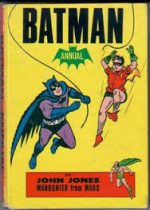
By Bill Finger, Jack Miller, Sheldon Moldoff, Joe Certa, Dick Sprang, Henry Boltinoff & various (Atlas Publishing & Distributing Co. Ltd/K. G. Murray Publishing)
No ISBN
Before DC Comics and other American publishers began exporting directly into the UK in 1959, our exposure to their unique brand of fantasy fun came from licensed reprints. British publishers/printers like Len Miller, Alan Class and Top Sellers bought material from the USA – and occasionally Canada – to fill 68-page monochrome anthologies – many of which recycled the same stories for decades.
Less common were the strangely coloured pamphlets produced by Australian outfit K. G. Murray and exported to the UK in a rather sporadic manner. The company also produced sturdy Annuals which had a huge impact on my earliest years (I strongly suspect my adoration of black-&-white artwork stems from seeing supreme stylists like Curt Swan, Carmine Infantino, Gil Kane and Murphy Anderson uncluttered by flat colour…).
In Britain we began seeing hardcover Atlas Batman Annuals in 1960 and, due to the vagaries of licensing, once the TV series started in 1966 were soon inundated with a wealth of choices as Top Sellers and World Distributors (Batman Storybook Annuals) released their own collections between 1967 and 1970.
Since then a number of publishers have carried on the tradition but only one at a time…
This particular tome emerged at the start of that Batman phenomenon which briefly turned the entire planet Camp-Crazed and Bat-Manic, and offers a delightfully eclectic mix of material crafted just before Julie Schwartz’s 1964 stripped-down relaunch of the character.
Here crimebusting is intermixed with alien fighting and idle daydreaming with the world’s greatest crime-fighters indulging in a comfortably strange, masked madness that was the norm in the Caped Crusader’s world.
This collection is printed in the cheap and quirky mix of alternatively monochrome, dual-hued and full-colour pages which made Christmas books such bizarrely beloved treats.
The sublime suspense and joyous adventuring begins with ‘The Return of the Second Batman and Robin Team’ by Bill Finger & Sheldon Moldoff from Batman #135 (October 1960): a sequel to a tale within a tale wherein faithful butler Alfred postulated a time when Bruce Wayne married Batwoman Kathy Kane and retired to let their son join grown-up Dick Grayson as a second generation Dynamic Duo.
Here the originals are forced to don the bat mantles one last time when an old enemy captures the new kids on the block…
British books always preferred to alternate action with short gag strips and the Murray publications depended heavily on the amazing output of DC cartoonist Henry Boltinoff. Delivery man ‘Homer’ then suffers a canine interruption before Batman invades ‘The Lair of the Sea Fox’ (Batman #132; (June 1960, by Finger, Moldoff & Charles Paris). The nefarious underwater brigand’s schemes to use Gotham City’s watery substructure to facilitate his plundering soon founders when the Caped Crusaders break out the Bat-Sub…
Boltinoff’s crystal-gazing ‘Moolah the Mystic’ clears up the ether his way as a prelude to the introduction of this Annual’s engaging co-star. John Jones, Manhunter from Mars debuted at the height of American Flying Saucer fever in Detective Comics #225. He was created by Joe Samachson, and is arguably the first superhero of the Silver Age, beating by a year the new Flash (who launched in Showcase #4 cover-dated October 1956).
The eccentric, often formulaic but never disappointing B-feature strip depicted the clandestine adventures of stranded alien J’onn J’onzz. Hardly evolving at all – except for finally going public as a superhero in issue #273 (November 1959) – the police-centred strip ran in Detective until #326, (1955- 1964 and almost exclusively written by Jack Miller from issue #229 and illustrated from inception by Joe Certa) before shifting over to The House of Mystery (#143 where he continued until #173) and a whole new modus vivendi.
He temporarily faded away during the Great Superhero Cull of 1968-70 but is back in full fettle these days.
His origins were simple: reclusive genius scientist Dr. Erdel built a robot-brain which could access Time, Space and the Fourth Dimension, accidentally plucking an alien scientist from his home on Mars. After a brief conversation with his unfortunate guest, Erdel died to a heart attack whilst attempting to return J’onzz to his point of origin.
Marooned on Earth, the Martian discovered that his new home was riddled with the ancient and primitive cancer of Crime and – being decent and right-thinking – determined to use his natural abilities (telepathy, psychokinesis, super-strength, speed, flight, vision, super-breath, shape-shifting, invisibility, intangibility, invulnerability and more) to eradicate evil, working clandestinely disguised as a human policeman. His only concern was the commonplace chemical reaction of fire which sapped Martians of all their mighty powers…
With his name Americanised to John Jones he enlisted as a Middletown Police Detective: working tirelessly to improve his new home; fighting evil secretly using inherent powers and advanced knowledge with no human even aware of his existence. Here in a thriller from Detective #299 (January 1962) Miller & Certa’s ‘Bodyguard for a Spy’ sees the mighty Manhunter almost fail in his mission because his human assistant Diane Meade is jealous of the beautiful Princess in his charge…
The magnificent Dick Sprang – with Paris inking – astoundingly illustrated Finger’s script for ‘Crimes of the Kite Man’ (Batman #133, August 1960): a full-colour extravaganza with the Caped Crusader hunting an audacious thief plundering the skyscrapers of Gotham whilst ‘The Deadly Dummy’ (Finger, Moldoff & Paris from Batman #134, September 1960) pitted the Dynamic Duo against a diminutive showman-turned-bandit fed up with being laughed at…
Reverting to monochrome, ‘The Martian Show-Off’ (Detective #295, September 1961) poses a confusing conundrum as the eerie extraterrestrial connives to inexplicably deprive a fellow cop of his prestigious 1000th arrest after which ‘Batman’s Interplanetary Rival’ (Detective Comics #282, August 1960) by Finger Moldoff & Paris finds the human heroes constantly upstaged by an alien lawman hungry for fame and concealing a hidden agenda before the interplanetary intrigue – and the Annual action – ends with The Mystery of the Martian Marauders’ (Detective Comics #301, March 1962) as deranged scientist Alvin Reeves fixes Erdel’s robot brain and accidentally brings Martian criminal invaders to Earth. After battling impossible odds the Manhunter triumphs and wins the ability to return at any time to his birthworld…
Cheap, cheerful and deliriously engaging this is a nostalgic treat no baby-boomer could possibly resist
© National Periodicals Publications Inc., New York 1967. Published by arrangement with the K. G. Murray Publishing Company, Pty. Ltd., Sydney.
Smash! Annual 1972
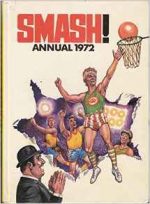
By many and various (IPC Magazines, Ltd)
SBN: 901267-62-7
Power Comics was a sub-brand used by Odhams to differentiate those periodicals which contained reprinted American superhero material from the company’s regular blend of sports, war, western, adventure and humour comics – such as Buster, Lion or Tiger.
During the Swinging Sixties the Power weeklies did much to popularise the budding Marvel universe characters in this country, which was still poorly served by distribution of the original American imports.
Smash! launched with a cover-date of February 5th 1966: an ordinary Odhams anthology weekly which was quickly re-badged as a Power Comic at the end of the year; combining home-grown funnies and British originated thrillers with resized US strips to capitalise on the American superhero bubble created by the Batman TV series.
By a process of publishing attrition it had become Britain’s last general purpose, non-themed weekly of the century. After it was gone all successive debuts were umbrella vehicles specifically focusing on War, Sport, Science Fiction or Humour in dedicated titles such as Battle, Shoot!, 2000AD or Whoopee!
The increasingly expensive American reprints were dropped in 1969 and Smash! was radically retooled with a traditional mix of action, sport and humour strips. Undergoing a full redesign it was relaunched on March 15th 1969 with all-British material and finally disappeared into Valiant in April 1971 after 257 issues. However, the Seasonal specials remained a draw until October 1975 when Smash Annual 1976 properly ended the era. From then on the Fleetway brand had no room for the old guard – except as re-conditioned reprints in cooler, more modern books…
As I’ve monotonously repeated, Christmas Annuals were forward-dated so this monumental mix of shock, awe and haw-haw was probably being put together between spring and September 1971, combining new strip or prose stories of old favourites with remastered reprints from other Odhams’ comics and a wealth of general interest fact features.
Following a contents page/cast pin-up double page spread, the action kicks off with ‘Moonie’s Magic Mate’ – sublimely painted by Carlos Cruz – detailing how the lucky lad’s bellicose genie hijacks him back to ancient Baghdad and gets into a duel with another stroppy wish-granter.
Then the monochrome section starts with Leo Baxendale’s ‘The Swots and the Blots’ – possibly crafted here by Mike Lacey – who put their long-suffering teacher through another hellish week whilst the initial prose thriller sees flying teen ‘Birdman from Baratoga’ return to the island where he was reared by gulls and other avians. Here he encounters a mad scientist with a paralysis ray before prankish ‘Sam’s Spook’ (Terry Bave?) gets his adopted mortal into more trouble.
‘It’s Wacker’ – originally Elmer when first seen in Buster – finds the un-able seaman accidentally sinking every naval berth he occupies, whether land-based or sea-borne, in a riotous romp from Roy Wilson before showman ‘Janus Stark’ makes himself a guinea pig for scientists and discovers a new ability in time to foil an audacious society thief…
Janus Stark was a fantastically innovative and successful strip. Created by Tom Tully for the relaunch of Smash in 1969, the majority of the art was from Solano Lopez’s Argentinean studio, and the eerie moodiness well suited the saga of a foundling who grew up in a grim orphanage to become the greatest escapologist of the Victorian age.
The Man with Rubber Bones also had his own ideas about Justice, and would joyously sort out scoundrels the Law couldn’t or wouldn’t touch. A number of creators worked on this feature which survived until the downsizing of Fleetway’s comics division in 1975 – and even beyond – as Stark escaped oblivion when the series was continued in France – even unto Stark’s eventual death and succession by his son!
Right here, back then we resume with ‘The Haunts of Headless Harry’ which sees the phantom’s pate at war with his torso at a spectral carnival after which monochrome photo-essay ‘“Timb-err!‒ lays out the details on the glamorous career of lumberjacking in Canada.
Hapless fantasist ‘Big ‘Ead’ (another Buster graduate, limned by Nadal) dreams of a life under the big top whilst social injustice and class war catastrophically break out in Reg Parlett’s deliriously witty ‘Consternation Street’…
‘Send for Q-Squad’ – by an artist I recognise but can’t name – finds the elite 5-man team cutting short leave in Cairo to track down and destroy an experimental Nazi death-ray projector in an epic-length exploit, after which ‘Monty Muddle – The Man from Mars’ (originally Milkiway – The Man from Mars in Buster) explores Earth’s penal customs and ‘Smash Hits’ doles out a double helping of single-panel gags.
‘Four-Legged Cops!’ gives the photo-essay lowdown on the history and role of police dogs in Britain, after which ‘Percy’s Pets’ (Stan McMurtry or just possibly Cyril Price) adds a truly pestilential parrot to his menagerie before the compellingly macabre school strip ‘Master of the Marsh’ (Solano Lopez) sees enigmatic hermit/P.E. teacher Patchman roughly dealing with his regular tribe of hooligans and poachers too, to save badgers from being sold as zoo exhibits…
You might have noticed a preponderance of supernatural humour strips here and another follows when the magnificent and prolific Reg Parlett ushers us aboard his chaotic ‘Ghost Ship’ and wannabe pop stars ‘Nick and Nat – The Beat Boys’ (originally The Wacks when they played in Wham! – no, not them, the comic Wham!) experience a little guitar trouble. A full-colour photo-feature then reveals all the secrets of life in the Household Cavalry in ‘Men of Steel’…
‘The World-Wide Wanderers’ were a literally international team of footballers drawn from many different countries – talk about prophetic! – who here star in a prose yarn about a cup final starting in a country riven by revolution and ending on an aircraft carrier at sea.
More nautical nonsense abounds as Wacker’ leads his shipmates on an insane sea safari sparked by a misidentified treasure map whilst a monochrome ‘Sporting Gallery’ of contemporary stars and headliners leads to more circus calamity in ‘The Haunts of Headless Harry’ before ‘Bulls-Eye’ offers snaps of and facts on Britain’s then-thriving boom in archery for kids.
Light-hearted everyman ‘His Sporting Lordship’ was one of the most popular strips of the era. Debuting in Smash!, Henry Nobbins survived the merger with Valiant and only retired just before the comic itself did.
Nobbins was a common labourer when he unexpectedly inherited £5,000,000 and the title Earl of Ranworth. Unfortunately, he couldn’t touch the cash until he restored the family’s sporting reputation… by winning all the championships, prizes and awards that his forebears had held in times past…
Further complicating the issue was rival claimant Parkinson who, with henchman Fred Bloggs, constantly tried to sabotage his attempts. Luckily the new Earl was ably assisted by canny, cunning butler Jarvis…
Here (with art by Douglas Maxted?), the capable manservant has his hands full as Henry joins a basketball team where his nemeses are trying to beat him at his own game…
Photo-facts about winter sports tantalise in ‘Snow Men’ whilst ‘Big ‘Ead’ boasts of his sledding expertise after which ‘Lucky to Live!’ reveals a quartet of actual narrow escapes in a prose essay describing being swallowed by a whale, sinking in quicksand, shooting a man-eating lion and extinguishing an engine fire by climbing onto a plane’s wing… without landing first…
‘The Swots and the Blots’ then tackle a coal mountain in the playground and ‘Master of Escape!’ offers a lavishly illustrated history feature on escapologist Harry Houdini before ‘Consternation Street’ and ‘Monty Muddle’ create a lighter mood as we slip comfortably into the two-colour section (Black and orange, this year) for potted histories of ‘Warriors of the World’ Clive of India and Lawrence of Arabia.
‘Sam’s Spook’ then repopulates a haunted castle devoid of phantoms before Smash’s veteran troubleshooter and action-man barely survives ‘Simon Test’s Million-Pound Gamble’ after two aged One-Percenters wager on his ability to avoid their booby-trapped estate in a supreme thriller by Eric Bradbury or a very skilled ghost-artist…
General knowledge and observational skills are challenged in ‘Mike’s Quick Quiz’, the ‘Ghost Ship’ meets its maritime match and ‘The Beat Boys’ play one final encore as very bad buskers before this compendium of fact fun and thrills concludes with a spectacular and suspenseful Sci Fi thriller reprinted from Buster and moodily limned by Solano Lopez. Here, soon to be veteran villain Doctor Droll debuts, having unleashed a wave of killer action figures on a small English town in ‘March of the Toys’ with only plucky kids Jo and Sandy Douglas aware of his schemes or prepared to stop him.
An interesting and pleasing side-note is that in this lengthy yarn, sister Jo is a crucial component and fully equal partner in the villain’s defeat. That’s a pretty big deal in a boys’ comic story from a period where females almost never appeared except as comedy foils or frustrating authority figures…
As my knowledge of British creators from this time is so woefully inadequate, I wouldn’t be surprised if I’ve misattributed and besmirched the good names of Leo Baxendale, Mike Brown, Gordon Hogg, Stan McMurtry, Graham Allen, Mike Lacey, Terry Bave, Artie Jackson and numerous international artists anonymously utilised throughout this period. Even more so the unsung authors responsible for much of the joy in my early life – and certainly the childhoods of millions of others…
Christmas simply wasn’t right without a heaping helping of these garish, wonder-stuffed compendia offering a vast variety of stories and scenarios. Today’s celebrity, TV and media tie-in packages simply can’t compete, so why not track down a selection of brand-old delights with proven track record and guaranteed staying power…?
© IPC Magazines, Ltd. 1971.


